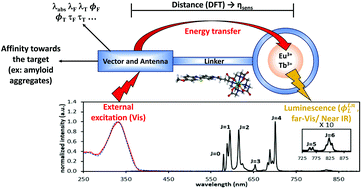Photophysical studies on lanthanide(iii) chelates conjugated to Pittsburgh compound B as luminescent probes targeted to Aβ amyloid aggregates†
Abstract
The photophysical properties of Eu3+ and Tb3+ complexes of DOTAGA and DO3A-monoamide conjugates of the Pittsburgh compound B (PiB) chromophore, prepared using linkers of different lengths and flexibilities, and which form stable negatively charged (LnL1), and uncharged (LnL2) complexes, respectively, were studied as potential probes for optical detection of amyloid aggregates. The phenylbenzothiazole (PiB) moiety absorbs light at wavelengths longer than 330 nm with a high molar absorption coefficient in both probes, and acts as an antenna in these systems. The presence of the luminescent Ln3+ ion quenches the excited states of PiB through an energy transfer process from the triplet state of PiB to the metal centre, and structured emission is seen from Eu3+ and Tb3+. The luminescence study indicates the presence of a 5D4 → T1 back transfer process in the Tb3+ complexes. It also provides insights on structural properties of the Eu3+ complexes, such as the high symmetry environment of the Eu3+ ion in a single macrocyclic conformation and the presence of one water molecule in its inner coordination sphere. The overall quantum yield of luminescence of EuL1 is higher than for EuL2. However, their low values reflect the low overall sensitization efficiency of the energy transfer process, which is a consequence of the large distances between the metal center and the antenna, especially in the EuL2 complex. DFT calculations confirmed that the most stable conformation of the Eu3+ complexes involves a combination of a square antiprismatic (SAP) geometry of the chelate and an extended conformation of the linker. The large calculated average distances between the metal center and the antenna point to the predominance of the Förster energy transfer mechanism, especially for EuL2. This study provides insights into the behavior of amyloid-targeted Ln3+ complexes as optical probes, and contributes towards their rational design.



 Please wait while we load your content...
Please wait while we load your content...